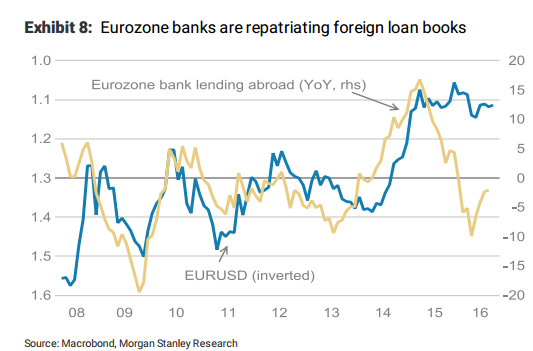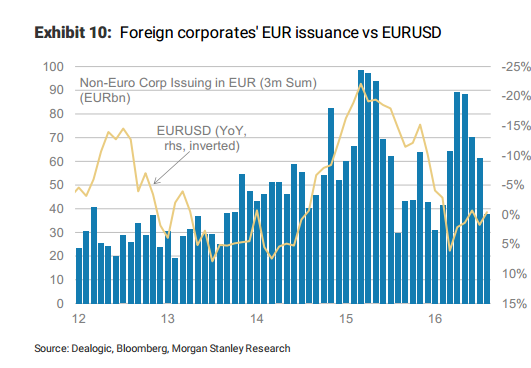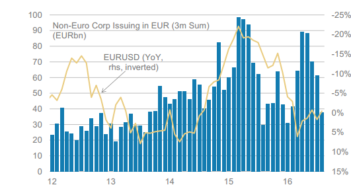EUR/USD did not move too much on Draghi’s lack of details and lacks a new direction. The team at Morgan Stanley sees a bullish run and explains.
Here is their view, courtesy of eFXnews:
Why bank profits matter for FX? There are two main reasons why bank profitability should matter for an FX investor.
Firstly, higher expected returns could cause banks to start to lend outside their own region, which would weaken the domestic currency as the money borrowed from the local central bank is swapped into a foreign currency.
Secondly, a healthy banking sector should promote local risk taking, which if feeds through into higher inflation, would normally strengthen a currency. EUR higher from bank repatriation.
The Eurozone is a great example of where declining bank returns have affected the currency. The ECB cutting interest rates to 0.05% at the end of 2014 caused Eurozone bank activity to pick up significantly since the banks could fund themselves at even lower rates.
Eurozone bank foreign lending books picked up, growing at their peak at 15%YoY in April 2015 (Exhibit 8), a process that helped the EUR to weaken. There were two periods that followed. Firstly, the EUR stopped weakening as Eurozone bank foreign loan growth started to contract due to little demand. Secondly,and a process that is still occurring, low bank returns and generally weak balance sheets caused these Eurozone banks to close out of their foreign loan books, repatriating the proceeds and thus supported the EUR.
Going forward if bank profitability stays low then we are likely to see further repatriation, adding to our bullish EUR view.

Low profitability–>low risk taking. The issue central banks face today is that extra liquidity injections sent into the banking sector are not finding their way into the real economy.Low profitability is actually making it difficult for banks to accept more risk. In this line of thought, the banks may also aim for allocating capital into a very low risk strategy involving low yielding investments and keeping more cash on their balance sheet, deposited at the central bank. Currencies will ultimately find it difficult to weaken without the banks’ willingness to take on risk outside their own country.

EUR funding flows turn low. An important pillar of our EUR bullish interpretation suggests that the EUR does not work as a funding currency. Bank capital retreating from abroad indicates that bank funding for foreign carry may not kick in translating negative front-end rates into FX weakness. Moreover, the widening of the EURUSD base has made it unattractive for non-EMU entities to issue within the EUR denominated corporate bond market as illustrated in Exhibit 10. Total issuance by non-EMU based entities has declined suggesting that even the corporate bond market does not work as a funding tool either.
Hopes that expiring EMU bonds could lead to Euro weakness may be premature as those flows kick in only slowly and are currently small in respect of other EUR relevant flows. Interestingly, the increasing share bonds held by central banks will reduce those repayment related flows additionally.
*Morgan Stanley expresses its EUR bullish view via long EUR/JPY position and long EUR/AUD limit order.*
For lots more FX trades from major banks, sign up to eFXplus
By signing up to eFXplus via the link above, you are directly supporting Forex Crunch.
